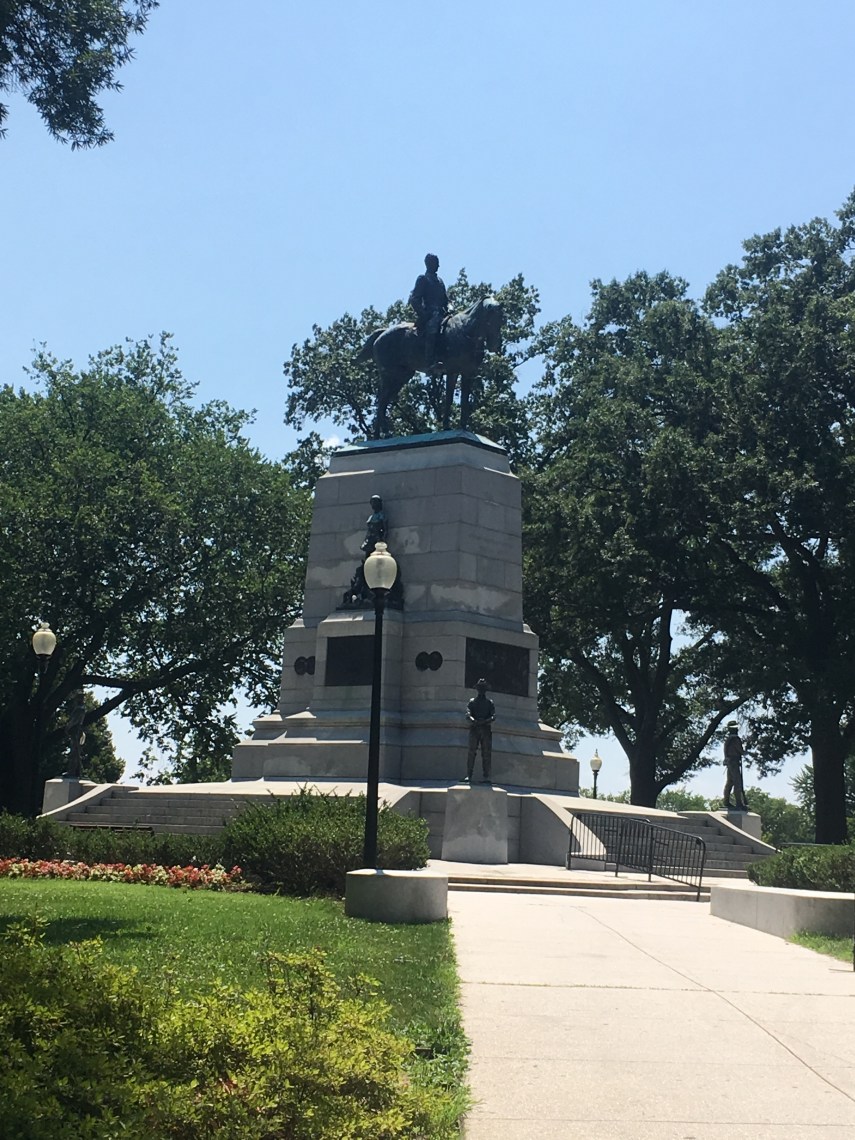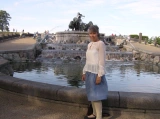Some War Statues in Washington DC
This post will contain squares and statues in walking distance of each other commemorating military leaders from different wars and historical subjects of interest.
The Revolutionary War (1775-1783).
Lafayette Square behind the White House. I always want to know who the memorials commemorate. They tell us a story about the past if we care to look it up.
At each of the square’s four corners stands statues of foreigners who took part in America’s struggle for liberty. The French General Marquis de Lafayette (1757-1834) also called “The Hero of the Two Worlds” for his accomplishments in the service of both France and the United States. And nobleman and general Rochambeau (1725-1807), the Polish general Thaddeus Kosciuszko (1746-1817) A close friend of Thomas Jefferson’s, with whom he shared ideals of human rights, Kościuszko wrote a will in 1798 dedicating his U.S. assets to the education and freedom of U.S. slaves. He eventually returned to Europe and lived in Switzerland until his death in 1817. The execution of his will later proved difficult, and the funds were never used for the purpose he had intended Quote from Wikipedia). For better pictures than mine see this blogger’s picture.
The fourth statue shows Prussian officer and Baron von Steuben (1730-1794) also an aid to George Washington at the battle of Valley Forge. Quote from Wikipedia: He is credited with being one of the fathers of the Continental Army in teaching them the essentials of military drills, tactics, and disciplines. He wrote Regulations for the Order and Discipline of the Troops of the United States, the book that served as the standard United States drill manual until the War of 1812. He served as General George Washington’s chief of staff in the final years of the war. I wish I had remembered to take a picture of his statue while we were there. This tourist site has a good photo.
An equestrian statue of President Andrew Jackson stands in the middle of the square. At his time he was celebrated as the winner of the War of 1812. The English army had destroyed much of the newly built Washington D.C. The Capitol, the White House, the War Department, and the Treasury.
Freedom Plaza, Pennsylvania Avenue
The plaza displays Pierre L’Enfant’s original plan for Washington in black and white stone embedded in the ground. Around the edge you see quotations from famous men engraved. It’s a prominent place for skaters. One of my sons wanted badly to be with us to that place. In the Wikipedia article, it says that skateboarding is damaging for the memorial and illegal.
Adjacent to Freedom Plaza is Pulaski Plaza with the statue of Polish Casimir Pulaski. Like the foreigners honoured at Lafayette Square Pulaski was also a hero from the American Revolutionary War. He once saved George Washington’s life and was the father of the American Cavalry.
From The Civil War (1861-1865).
The Ulysses Grant Memorial in front of The Capitol, the start of The National Mall. To understand the hugeness of this, I would like you to see the short video about its restoration.
He is the central figure in this remarkable group of bronze equestrian statuary. The suffering of men and the 13 horses are hard to see in my photo as the trees are in the background. Shrady, the artist worked on this for twenty years and died shortly before dedication in 1922.
The Scott Hancock Statue at Pennsylvania Avenue opposite The National Archives.

Major General Winfield Scott Hancock close to The Navy Memorial and The National Archives
This bronze equestrian statue on a red granite base is in honour of the Civil War general who successfully repelled the Confederate attack in the Battle of Gettysburg.
I had to ask my husband Henry to search for information on the Sherman Memorial. He found this blogger from Washington D.C. who uses his lunch breaks to look at the many sights in his capital. I would like to recommend his page and expertise as a local from Washington.
The Sherman Memorial at the Penn Quarter in the corner of the White House area. The memorial is behind a security fence which hinders visitors to come close enough to see the details in the panels and inscriptions. Our dear family in Virginia also helped me to identify the statue.

William T. Sherman at 15th Street. On panels underneath Sherman are figures representing War and Peace and soldiers representing infantry, Calvary, artillery, and engineers
First World War Pershing Park, The Penn Quarter
It is here that our nation honours John J. Pershing, whose World War I leadership propelled him to the rank of General of the Armies—a rank he shares only with George Washington. Qoute from The National Park Service
These sights were all found during a walk between The White House and The Capitol via Pennsylvania Avenue. I will continue with some of the memorials inside the National Mall.
There is a reason why these men are honoured and depicted on these extravagant statues and parks. They have caused a difference in the wars in the past that without them history had turned out into another story.
Categories: Sightseeing, Travelling, USA



















Thank you, Maria.
LikeLiked by 1 person
I am glad you liked it.
LikeLiked by 1 person
I was so tempted to tell you that it was a complicated post to create
LikeLiked by 1 person
I enjoyed your blog very much but you made me think of something I never have before…..who were the artists/makers of all the beautiful and amazing statues and memorials world wide. You mentioned Shrady. Just one of thousands. Of course the reason for the memorials is why they are there.
LikeLiked by 1 person
Thank you for commenting. You are right. I aught to mention that on each of them. I will try to fix that. These artists were so gifted to make an expression of heroes from the past
LikeLike
Australia doesn’t have huge mountains but the highest peak in Australia is Mt Kosciuszko
which was name by the person who first discovered it after General Taddeus Kosciuszko.
LikeLiked by 1 person
I am so glad you told me that. It could be explained in a blog post if you would.
LikeLike
OK. I will work on one.
LikeLiked by 1 person
So interesting
LikeLike
Brilliant post. I’m always fascinated by statues, memorials, interesting buildings, and the stories behind them.
LikeLiked by 1 person
Thank you so much, a huge encouragement for continuing posting
LikeLiked by 1 person
🙂 That makes me really happy!
LikeLiked by 1 person